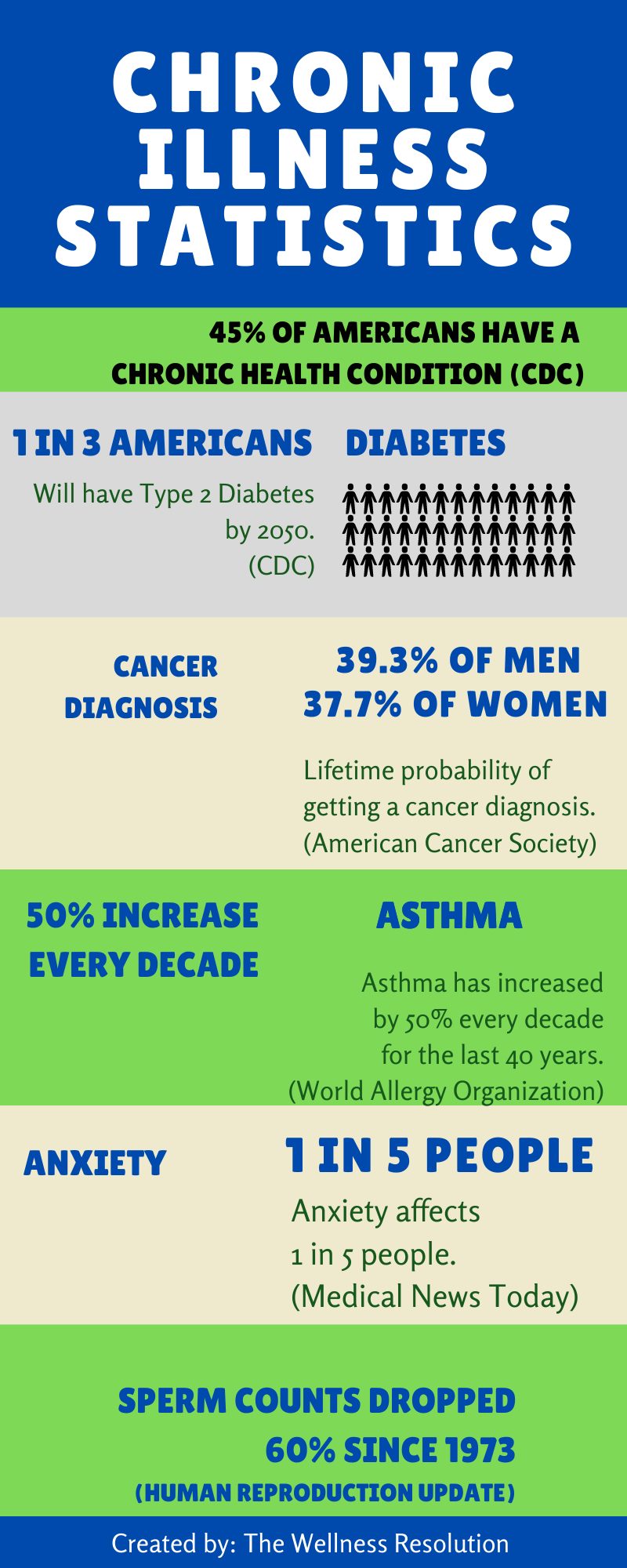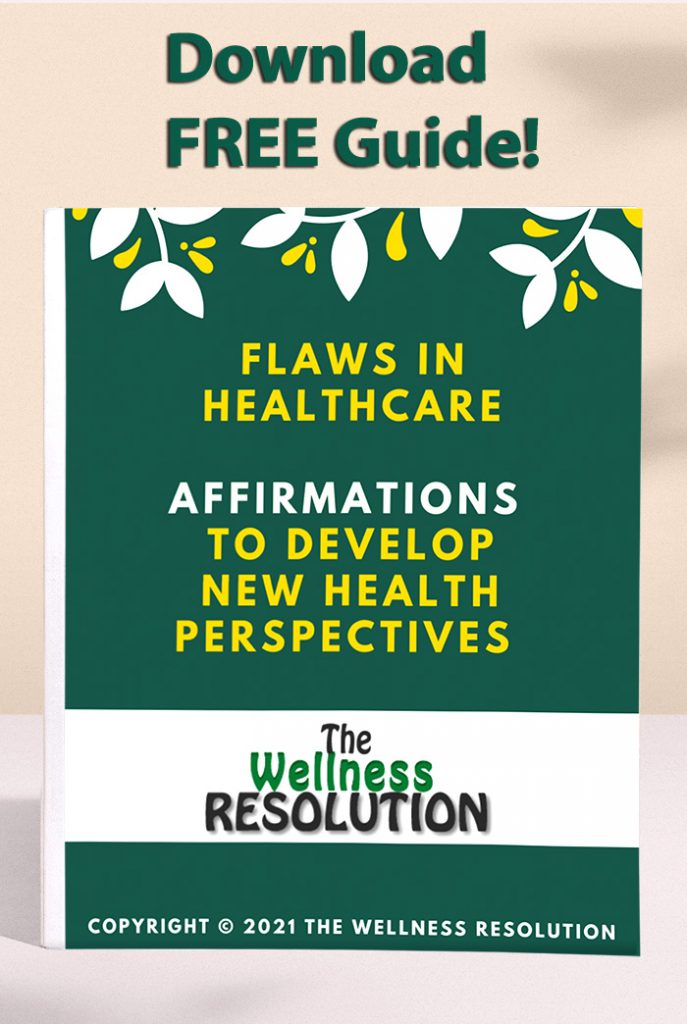Table of Contents
Practically All Chronic Illnesses and Diseases Are Becoming More Common!
Nearly half (approximately 45%, or 133 million) of all Americans suffer from at least one chronic disease [3,4,5], and the number is growing (Raghupathi, 2018). We don’t see it because many of these illnesses are an invisible illness.

45% of Americans with an Ongoing Health Condition
Chronic illness is an ongoing health condition that lasts 3 months to a year or more and limits a person, causes functional restrictions in day-to-day activities, requires ongoing monitoring, or treatments. A chronic illness can reduce a person’s quality of life, lead to hospitalization, long-term disability, or even death.
It has happened so slowly over time that we just see these things as normal changes in the world. Most health conditions are hidden and are often referred to as invisible illnesses. Food sensitivities are being normalized, more people are struggling with migraines, more people with depression, anxiety, hormonal problems, back pain, IBS, and fatigue. There are also more autoimmune diseases and hard-to-diagnose health conditions.
When will society see we have a problem?
Where are we going to draw the line in the sand and say this is a HUGE problem we have a chronic illness crisis? Society, in general, is not acknowledging it.
Another problem is many get caught up in the fact that we have more so-called “cures” for cancers, early diagnosis, and fewer people dying from cancer. However, every year more and more people are being diagnosed with cancer those numbers are not going down. Those numbers are going up! Just because we have better advances in chemotherapy, doesn’t mean we should just roll the dice taking our chances on whether or not we end up with cancer or not. I’m sure most of the people who have gone through chemotherapy would tell you, “if I had known how to take preventative measures to prevent cancer I would have tried!”
Life expectancy has gone up, but the quality of life has gone down. Yes, many people are living longer, but more people are living with ongoing pain or illnesses.
Today vs. 100 years ago: Today we have more sugar added into our foods, more unhealthy processed grains, GMOs, overconsumption of milk & other dairy products, livestock is being fed GMO grains instead of the food from the land, and much, much more. As I discuss in the “Clean Eating” section of my blog these things all contribute to our health crisis.
Many Don’t Recognize a Chronic Health Issue – It’s Just Part of Their Normal
 You might be part of the 40-45% without even realizing it! Do you suffer from… ongoing or regular occurrences of anxiety, depression, fatigue, back pain, IBS, hormone imbalances, chronic migraines, inflammation, thyroid/adrenal problems, or autoimmune problems in general?
You might be part of the 40-45% without even realizing it! Do you suffer from… ongoing or regular occurrences of anxiety, depression, fatigue, back pain, IBS, hormone imbalances, chronic migraines, inflammation, thyroid/adrenal problems, or autoimmune problems in general?
ALSO, symptoms such as frequent fatigue, an increase in migraines, etc. could be a sign of a health condition that is present or developing slowly.
Do you have a condition that limits you in any way? Requires you to take some form of medication to get by? Or need some sort of device?
Many people suffer from some health condition that has just become part of their normal. For others, there is no more “normal.” Their life has been turned upside down.
You Don’t Want a Debilitating Chronic Illness
I read content all the time written by severe chronic illness sufferers. I was one, and I write content for them. You do not want to be part of the chronic illness community. I don’t wish that for anyone, and I don’t feel at all happy to have more people who can relate to the things I’ve struggled with.
Chronic illness is incredibly expensive in so many ways, financially, physically, mentally, emotionally! In addition, finding the right practitioner to help, and making adjustments to live with an illness is very challenging. Sometimes you feel like you are just throwing money down a pit because you get minimal to no results. Some of it has been worth it, and some of it has been a huge disappointment. Even just having a food sensitivity is a huge annoyance. Trust me, paying more for groceries, and taking the time to make more healthy decisions is all worth it!!
 Chronic Illness costs roughly $5,300 per year (according to the CDC). If you spend just $50 extra in groceries a week that is $2,400 a year, so you are coming out ahead. That is not even accounting for the emotional and physical costs of being chronically sick.
Chronic Illness costs roughly $5,300 per year (according to the CDC). If you spend just $50 extra in groceries a week that is $2,400 a year, so you are coming out ahead. That is not even accounting for the emotional and physical costs of being chronically sick.
Spending even $200 more a month to pick out healthier foods is WORTH IT!
The Health of Our Country is Deteriorating!
Invisible illness is becoming more common.
One of the more visible things we see is an increase in food sensitivities.
We all know someone who has a gluten intolerance, a dairy sensitivity, or maybe a soy sensitivity. There are reasons for this, and the possibility of preventing sensitivities. But, it all depends on how unhealthy the gut is already. It is possible that 30-50% of the population has a food sensitivity (but we have no accurate numbers currently). Sometimes you can have a food sensitivity from something you consumed nearly 3 days ago, so it can be hard to tell what you are sensitive to. Symptoms can show up in a number of ways such as stomach discomfort, diarrhea, general body aches, constipation, etc.
STATISTICS
Autoimmune Disorders in general are becoming more popular!
Educate Kids (1)  Other ailments becoming more popular are celiac disease, digestive issues (IBS), chronic migraines, chronic fatigue, back problems, hormone problems, and just chronic inflammation in general. There are also many people young people struggling with fibromyalgia, arthritis, rheumatoid arthritis, and diabetes.
Other ailments becoming more popular are celiac disease, digestive issues (IBS), chronic migraines, chronic fatigue, back problems, hormone problems, and just chronic inflammation in general. There are also many people young people struggling with fibromyalgia, arthritis, rheumatoid arthritis, and diabetes.
We have an Obesity and Diabetes Epidemic!
From 1983 to 2011 worldwide diabetes prevalence increased from 35 million to 366 million and is projected to grow to 552 million in 2030 (Hyman, 2012). Diabetes can cause kidney failure, heart attacks, and strokes.
Cancer Rates have Increased
Even though death rates are said to have decreased over the years, more people are being diagnosed with cancer. The probability of getting cancer is a bit too high if you ask me! The lifetime probability of being diagnosed with cancer is 39.3% for men and 37.7% for women, which is a little more than 1 in 3 according to the American Cancer Society. Of course, that is throughout our lifetime, so the chances of getting cancer are higher the older we get.
Childhood cancer has also risen every decade view: Key Statistics for Childhood Cancers
Allergies are More Common
It’s well documented that asthma and allergies are more common in children today than 100 years ago. Why? Some possible reasons here: Does Where You Live Matter? How Environment Impacts Asthma and Allergies
Figures from the World Allergy Organization reveal the global prevalence of asthma has increased by an astounding 50 percent every decade for the past 40 years (Smith, 2010).
Dementia and Alzheimers are More Common
One in three seniors dies with Alzheimer’s or another dementia (Alzheimer’s Association). MORE THAN 6 MILLION AMERICANS ARE LIVING WITH ALZHEIMER’S. BY 2050, THIS NUMBER IS PROJECTED TO RISE TO NEARLY 13 MILLION (Alzheimer’s Association).
Mental Health Problems Have Increased
Generalized Anxiety Disorder is also a very common struggle that I hear about from many people, especially with the millennial generation. Anxiety isn’t a bad thing once in a blue moon, but it’s a problem if it is a common occurrence or an ongoing struggle.
From Medical News Today, “anxiety disorders are the most common mental illness in the U.S.,” affecting around 40 million adults — almost 1 in 5 people.
Depression is also becoming more common. From 2005-15, cases of depressive illness increased by nearly a fifth (Jowit, 2018).
Chronic disease is a slow-motion disaster, a tsunami of suffering whose global cost will be $47 trillion over the next 20 years. – Dr. Mark Hyman, 2012
It’s Not Just Numbers
Maybe some of the numbers are skewed. In fact, the number of people with a chronic health condition is likely higher. But you don’t need numbers to see it. Natural health practitioners are seeing the problem growing, and medical doctors are getting in more people with chronic health conditions that they don’t know how to help. I consistently hear of more people dealing with ongoing health issues every year. It can be a bit un-obvious since many chronic illnesses are often invisible illnesses with no outward physical signs someone is struggling, but just look around and ask around. You might be surprised.
 The End (I apologize in advance, this is scary to consider)
The End (I apologize in advance, this is scary to consider)
A new book called Countdown, by Shanna Swan, an environmental and reproductive epidemiologist at Icahn School of Medicine at Mount Sinai in New York, finds that sperm counts have dropped almost 60% since 1973. (The Guardian, 2021). If things don’t change, this research suggests by 2045 sperm counts will be at ZERO! Yes, no more babies meaning no more humans.
No one can truly predict that date, but we do have a limit to how far we can go in this unhealthy direction before it truly is the end of civilization. This is preventable!
Does this all sound really stressful?
The reason I’m telling you all this is not to stress you out, but because a lot of these health conditions can often be prevented! But I know it is stressful, so I just try to do my best to take care of my health and help others. By understanding the causes and how to view our health the right way (not how society has taught us) we can take better control of it. I offer some ideas on how we can view our health the right way vs how society taught us to with my Flaws in Healthcare blogs. For an overall summary of all my “flaws in healthcare blogs” view: Flaws in Healthcare Making & Keeping People Sick.
We can reverse this trend!!!! My intent for this blog is to provide an easy-to-follow road map toward healthier decisions in a way that won’t feel super overwhelming.
Learn more about The Wellness Resolution here.

Download My Free Flaws in Healthcare Guide:
Affirmations and Tips to Developing Healthier Perspectives
View my Flaws in Healthcare Blogs:
- Flaws in Healthcare Making & Keeping People Sick
- Perfect Weight Doesn’t = Healthy – Cellular Health Matters More
- ILLNESS is RARELY JUST PHYSICAL Problems
- How to Strengthen Your Immune System & Defend it When it’s Weak
- Facts on Germs & Immune Health to Uncover the LIES
- Cure vs Treatment & The MULTIPLE Problems with “CURES”
- Shocking History of Modern Medicine
- Expecting A Quick Fix & Relying TOO Much on Modern Medicine
- Why We Shouldn’t Wait to Fix Health Problems!
- How We Focus More on Short-Term Health vs Long-Term Health
Resources:
CDC/About Chronic Diseases. Retrieved from: https://www.cdc.gov/chronicdisease/about/index.htm
Raghupathi, Wullianallur; Raghupathi, Viju. (2018, March 15). NCBI/An Empirical Study of Chronic Diseases in the United States: A Visual Analytics Approach to Public Health. Retrieved from: https://www.ncbi.nlm.nih.gov/pmc/articles/PMC5876976/#:~:text=Chronic%20diseases%E2%80%94including%2C%20cancer%2C,death%20%5B6%2C7%5D
American Cancer Society/Facts & Figures 2019: US Cancer Death Rate has Dropped 27% in 25 Years. (2019, January 8). Retrieved from: https://www.cancer.org/latest-news/facts-and-figures-2019.html
Brockovich, Erin. (2021, March 18). The Guardian/Plummeting sperm counts, shrinking penises: toxic chemicals threaten humanity. Retrieved from: https://www.theguardian.com/commentisfree/2021/mar/18/toxic-chemicals-health-humanity-erin-brokovich?fbclid=IwAR1sLUob5HpmFEWz_sviNQZX_jtix_myDdvrqp2mA_NeB4g6xYLPQ2crGPU
Dr. Hyman MD, Mark. (2012, January 27). DR. HYMAN/New Cure for Chronic Disease Discovered. Retrieved from: https://drhyman.com/blog/2012/01/27/new-cure-for-chronic-disease-discovered/
Smith, Gwen. (2010, November 20). Allergic Living/Why So Many Allergies – Now?. Retrieved from: https://www.allergicliving.com/2010/11/20/allergies-why-so-many-now/
Hertz, Beth Thomas. Allergy Asthma Network/Does Where You Live Matter? How Environment Impacts Asthma and Allergies. Retrieved from: https://allergyasthmanetwork.org/news/does-where-you-live-matter/
Medical News Today/Anxiety in the West: Is it on the rise?. Retrieved from: https://www.medicalnewstoday.com/articles/322877#Is-anxiety-increasing-in-the-U.S.?
Jowit, Juliette. (2018, June 4). The Guardian/What is depression and why is it rising? Retrieved from: https://www.theguardian.com/news/2018/jun/04/what-is-depression-and-why-is-it-rising
Alzheimer’s Association/Facts & Figures. Retrieved from: https://www.alz.org/alzheimers-dementia/facts-figures
I have a Wellness Coach Certificate, I’m an entrepreneur, an innovator, writer, and artist. My expertise includes over 7 years of marketing, research, and developing content for holistic health businesses. Plus, my own personal journey of becoming chronically sick: understanding what went wrong, and finding a way to heal and live a healthier life. I have a passion for wellness with a wealth of knowledge surrounding: wellness, flaws in healthcare, root causes for chronic illnesses, and alternative treatments.



